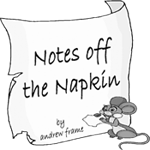 By Andrew Frame
By Andrew Frame
Occasionally we’ll get a referral from one of the local radio reps, most recently for a company that does home theatre sales, alarms, and such. The client was very business savvy, and he knew he wasn’t an advertising guy, he was a home theatre guy.
I like clients like that. I also like sales messages that hit the “what’s in it for me?” lifestyle factor of the listener. Identify the lifestyle you’re trying to reach, and build around that. It doesn’t have to be corporate-shill Sunday morning network television spots, either. You can have lifestyle, and sell, too.
I wrote a couple of :30’s to pin down a theme. The first took the humor turn, the second factual. He didn’t like either one. Over a few e-mails, we finally hammered out a :60 he was comfortable with. (The stations he was going to buy ran mostly :60’s.) I wasn’t crazy about the spot, but when you have advertising by committee, you have compromise.
He ran it for a month. Then I got this e-mail: “Hello Andrew, Feedback on the quality of the ad has been very positive. I did not break even on this go-around, but I think the market will be better in January. Should re-visit the ad itself? Since it will be a new time of year will this still have punch?”
Initially, my response is to stick to my 21-13 rule. If you run less than 14 to 21 spots a week in drive time and midday, don’t monkey with it for 13 to 26 weeks. We often forget that it takes time for the listener to become aware of a sales message. In order to create awareness that helps the consumer select where to shop, they have to hear the message to the point we radio folk are nauseated every time it airs since we’ve heard it so often.
You may get an initial listener response because it’s new. Then it may fizzle. Resist temptation to tinker. If you designed and produced the spot well, it’ll hold up through the flight. Unfortunately, clients see their money going out with no response after a small initial flurry. It’s very difficult to get a businessperson to continue to commit to spending, especially during a recession like we’re having in America at the dawn of 2008.
So, reps will come back to radio stations and let production know they need to come up with something new. They change the message or the approach, and restart. You have torn down and started to rebuild the house before the roof is on. That’s an irretrievable waste of money, time, and resources.
When I participated in “new salesperson training,” I tried to make two points:
Point #1: You do not sell advertising. You sell airtime. You sell the minutes that we develop advertising to populate. You do your job, and we’ll do ours.
Point #2: Our job is more than just to “make spots.” It’s to protect the company’s revenue stream, which also means we’re protecting your commission. We are in this with you, but you have to trust us.
The sales reps that have trusted, have been top billers with stable local-direct client lists, and spend the least amount of time trying to “explain what the client wants... this week.”
As an independent, we run into all the same problems the station reps run into. So, when the e-mail from our client came in, we made the decision to run what we had.
I threw the topic out to our producers network for opinions, too. Lori likes consistency: “I think you just need to remind him the importance of consistency. But, simplify a bit, you’ve got a lot going on. Do two or three spots as a “campaign” and have just one character, problem and solution in each.”
GM/GSM/AT/All Hat Wearer Joey is in the same position as me – the buck stops (and starts) with him. “Repetition builds reputation. (Gotta love the ol’ sales slogans!) Unless it runs ten times a day for weeks, leave it as is. The message is solid and compelling. The public may only just now be picking up on what’s going on in that ad.”
Albert went in a different direction: “While I see the importance of generating calls, it’s important to tell advertisers that most people “Google” a phone number when they want it. There’s no offer - that I remember. Services, yes. But nothing to make me say ‘I gotta call that guy.’”
Peter reinforced that it had no personal attachment: “I listened to it three times and found myself tuning out each time. Audio, interaction, editing, tone, intent, message... all good. What was missing was something that establishes the character, tone, flavor of the company. Like the AT&T spots of the 30’s through 70’s. They all connoted strength, innovation, reliability... the very backbone of our lives. Oh, by the way, they also sold phones. This spot presents a lot of solutions but there’s no subtext that says “we are solutions!”
“This is a very difficult type of client for which to do that. Like the phone company, the business is dry as sheetrock. You’ve got to create a persona for the business. Tweeter (Sound Advice) does all the things this business does. But they’ve made the presentation sexy... all very ‘Bond’-like… and make the listener think about issues they’ve not thought of as problems.”
So, all things considered, we’re going to run the spot as is for the next flight, while doing a makeover. We’ll go back to the personal realm, and see if we can get the client to commit, while putting enough “sell” into the message to get the phone to ring.
I love my job. It beats working any day.
♦

